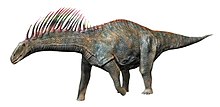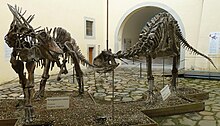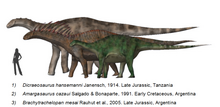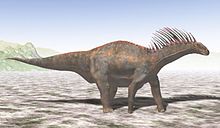Amargasaurus
| Amargasaurus Temporal range: Early Cretaceous,
| |
|---|---|

| |
| Amargasaurus skeleton cast in the Melbourne Museum foyer. | |
| Scientific classification | |
| Kingdom: | |
| Phylum: | |
| Class: | |
| Superorder: | |
| Order: | |
| Suborder: | |
| Infraorder: | |
| Superfamily: | |
| Family: | |
| Genus: | Amargasaurus
|
| Species: | A. cazaui
|
| Binomial name | |
| Amargasaurus cazaui | |
Amargasaurus (/əˌmɑːrɡəˈsɔːrəs/; "La Amarga lizard") is a genus of sauropod dinosaur from the Early Cretaceous epoch (129.4–122.46 mya) of what is now Argentina. The only known skeleton was discovered in 1984 and described in 1991, forming the holotype specimen of the single species Amargasaurus cazaui. The skeleton is nearly complete, including a fragmentary skull, making Amargasaurus one of the best-known sauropods from the Early Cretaceous. Amargasaurus was small for a sauropod, reaching 9 to 10 meters (30 to 33 feet) in length. It sported two parallel rows of tall spines down its neck and back, taller than in any other known sauropod. It is unclear how these spines appeared in life—they could have supported skin sails or stuck out of the body as solitary structures supporting a keratinous sheath. They might have been used for display, combat, or defense.
Amargasaurus was discovered in sedimentary rocks of the La Amarga Formation, which dates back to the Barremian and late Aptian of the Early Cretaceous epoch. It shared its environment with at least three other sauropod genera, which might have exploited different food sources in order to reduce competition. Amargasaurus probably fed at mid-height, as shown by the orientation of its inner ear and the articulation of its neck vertebrae, which suggest a habitual position of the snout some 80 centimeters (31 inches) above the ground and a maximum height of 2.7 meters (8.9 feet). Within the Sauropoda, Amargasaurus is closely related to the Late Jurassic genera Dicraeosaurus, Brachytrachelopan and Suuwassea. Together, these genera form the family Dicraeosauridae, which differ from other sauropods in showing very short necks and small body sizes.
Description

Amargasaurus was small for a sauropod, measuring 9 to 10 meters (30 to 33 feet)[1][2][3] in length and weighing approximately 2.6 metric tons (2.9 short tons).[1] It followed the typical sauropod bauplan, with a long tail and neck, a small head, and a barrel-shaped trunk supported by four column-like legs. The neck of Amargasaurus was shorter than in most other sauropods, a common trait within the Dicraeosauridae.[4] Measuring 2.4 metres (7.9 feet) in length,[4] the neck corresponds for 136% of the length of the dorsal vertebral column.[5] This is comparable to Dicraeosaurus (123%) but greater than in the extremely short-necked form Brachytrachelopan (75%).[5] The neck consisted of 13 cervical vertebrae, which were opisthocoelous (convex at the front and hollow at the back), forming ball-and-socket joints with neighboring vertebrae.[2] The trunk was made out of 9 dorsal and probably 5 fused sacral vertebrae.[2] The foremost dorsals were opisthocoelous, while the remaining dorsals were amphyplatyan (flat on both ends).[2] Robust transverse processes (lateral projections connecting to the ribs) indicate a strongly developed rib cage.[6] The dorsal vertebrae of Amargasaurus and other dicraeosaurids lack pleurocoels, the deep lateral excavations that were characteristic for other sauropods.[6]

The most striking feature of the skeleton were the extremely tall, upwardly projecting neural spines on the neck and anterior dorsal vertebrae. The neural spines were bifurcated along their entire length, forming a double row. They were circular in cross section and tapered towards their tips. The tallest spines could be found on the middle part of the neck, where they reached 60 centimeters (24 inches) on the 8th cervical.[2] On the neck, they were bowed backwards, projecting above the adjacent vertebra.[3] Greatly elongated spines continue along the last two dorsal vertebrae, the hip and foremost tail. However, in these regions the spines were not bifurcated but flared into a paddle-shaped upper end.[7] The pelvic region was relatively wide, judging from the long, laterally projecting transverse processes of the sacral vertebrae.[2] The forelimbs are somewhat shorter than the hindlimbs, as in related sauropods. Most of the hand and foot bones are not preserved, but Amargasaurus probably possessed five digits each as in all sauropods.[6]
Only the rear part of the skull is preserved. It likely showed a horselike, broad snout equipped with pencil-like teeth, as seen in related sauropods for which more complete skulls are known.[8] As in other dicraeosaurids, the external naris (nostril opening) was situated in the posterior half of the skull, diagonally above the eye socket, which was proportionally large.[6][9] As in most other dinosaurs, the skull featured three additional openings (fenestrae). The infratemporal fenestra, located below the eye socket, was long and narrow.[9] Behind the eye socket was the supratemporal fenestra, which in dicraeosaurids was uniquely small and can be seen when the skull is viewed from the side. This contrasts with other diapsid reptiles, where these openings were directed upwards, thus being visible only in top view.[2] In front of the eye socket, the antorbital fenestra would have been located, although this region is not preserved. An unusual feature were small openings seen on the backside of the skull, the so-called parietal openings or fontanelles. In other tetrapods, these openings are usually seen only in juveniles and would close as the individual grows.[10][11]
Discovery

The only known skeleton (MACN-N 15) was discovered in February 1984 by Guillermo Rougier during an expedition led by the famous Argentine paleontologist José Bonaparte. This was the eighth expedition of the project "Jurassic and Cretaceous Terrestrial Vertebrates of South America", which was supported by the National Geographic Society and initiated in 1975 with the aim to improve the at that time sparse knowledge of the Jurassic and Cretaceous tetrapod life of South America.[6][12] The same excursion uncovered the nearly complete skeleton of the horned theropod Carnotaurus.[13] The discovery site is located in the La Amarga Arroyo in the Picún Leufú Department of Neuquén Province, some 70 kilometers (43 miles) south of Zapala.[6][14] The skeleton stems from sedimentary rocks of the La Amarga Formation, which dates to the Barremian through early Aptian stages of the Early Cretaceous, or around 130 to 120 million years ago.[2]
The skeleton is reasonably complete and includes a partial skull. Sauropod skull bones are rarely found,[15] and the Amargasaurus skull is only the second skull known from the Dicraeosauridae. Major parts of the skeleton were found in their original anatomical position: The vertebral column of the neck and back, which consisted of 22 articulated vertebrae, was found connected to both the skull and the sacrum. Of the skull, only the temporal region and the braincase are preserved. The sacrum, despite being partly eroded prior burial, is fairly complete. Most of the tail is missing, with three anterior, three middle, and one posterior vertebrae being preserved, along with fragments of several others. The shoulder girdle is known from the scapula (shoulder blade) and coracoid (which sits on the lower end of the scapula), while the pelvis is merely known from the ilium (the uppermost of the three pelvic bones). The limbs are equally fragmentary, with the manus (hand) and most of the pes (foot) missing. The skeleton is currently stored in the collection of the Bernardino Rivadavia Natural Sciences Museum in Buenos Aires.[6]
The first, unofficial, mention of Amargasaurus as a new genus of dinosaur was published by Bonaparte in the 1984 Italian book Sulle Orme dei Dinosauria. Here, the species was designated as Amargasaurus groeberi, which was changed into Amargasaurus cazaui in the official description published several years later.[16] The official description, written in Spanish, has been published in 1991 by Leonardo Salgado and Bonaparte in the argentinian scientific journal Ameghiniana. The name Amargasaurus alludes to the site of discovery, the La Amarga Arroyo. La Amarga is also the name of a nearby town, as well as the geologic formation the remains were recovered from. The word amarga itself is Spanish for "bitter," while sauros is Greek for "lizard." The one species (A. cazaui) is named in honor of Luis Cazau, a geologist with the YPF oil company, which at the time was state-owned. In 1983, Cazau informed Bonaparte's team about the paleontological significance of the La Amarga Formation, leading to the discovery of the skeleton.[6] One year later, Salgado and Jorge O. Calvo published a second paper focussing on the description of the skull.[9]
Classification
Amargasaurus is classified as a member of the Dicraeosauridae, a family ranked clade within the Diplodocoidea. Currently, this clade consists of five species belonging to four genera. These are, besides Amargasaurus cazaui, the species Dicraeosaurus hansemanni and Dicraeosaurus sattleri from the Late Jurassic Tendaguru beds of Tanzania, and the recently described Brachytrachelopan mesai from the Late Jurassic of Argentina. Whitlock (2011) argued that Suuwassea emilieae from the Morrison Formation of the United States has to be placed inside the Dicraeosauridae as well, which was supported by subsequent studies.[17][18] Amargasaurus is the only named dicraeosaurid from the Cretaceous; however, an unnamed specimen from Brazil indicates that this group persisted until the end of the Early Cretaceous.[2] Most analyses find Dicraeosaurus and Brachytrachelopan to be more closely related to each other than to Amargasaurus.[5][19][20] Suuwassea was recovered as the most basal member of the family.[17] A recent analysis by Tschopp et al. (2015) came to the preliminary result that two poorly known genera from the Morrison Formation, Dyslocosaurus polyonychius and Dystrophaeus viaemalae, might be additional members of the Dicraeosauridae.[18]
Together with the Diplodocidae and the Rebbachisauridae, the Dicraeosauridae is nested inside the Diplodocoidea. All members of the Diplodocoidea are characterized by their box-shaped snout and narrow teeth restricted to the anteriormost portion of the jaws. Both the Dicraeosauridae and the Diplodocidae are characterized by bifurcated neural spines of the cervical and dorsal vertebra. In the Dicraeosauridae, the bifurcated neural spines were strongly elongated, a trend reaching its extreme in Amargasaurus.[8]

The following cladogram follows an analysis by Tschopp et al. (2015):[21]
Paleobiology
Vertebral spines

Both the appearance of the extremely elongated and bifurcated vertebral spines in life and their function remain elusive.[2] Salgado and Bonaparte (1991) suggested the spines to represent defense weapons against predators, arguing that they taper towards their tips.[6][11] Alternatively, they may had been used for display, either for the intimidation of rivaling conspecifics or for courtship.[6] In a subsequently published skeletal reconstruction drawing, Salgado (1999) depicted the neural spines supporting a keratinous sheath, which could have added significantly to the total length of the spines.[10][22][23] The presence of some kind of covering, either of keratin or skin, is shown by a striation pattern on the surface of the spines similar to the bony horn cores of today's bovids.[23]

As pointed out by Jack Bailey (1997), the spines resembled those of sail-bearing pelycosaurs like Dimetrodon. According to Bailey, Amargasaurus might also have possessed such a sail, which might have been used for display. Other than those of pelycosaurs, the neural spines of Amargasaurus were bifurcated, forming a double row along the neck and back. As the space between both rows was merely 3 to 7 centimeters (1.2 to 2.8 inches), the existence of two parallel sails seems unlikely. Instead, Bailey suggests the spines to represent a scaffold which was completely enveloped by a single skin.[7] American science writer Gregory Paul (2000) argued against the sail hypothesis, noting that neck sails would have reduced neck flexion, and that the spines were circular in cross-section rather than flatted as is the case in sail-bearing animals. The spines, if elongated by an keratinous sheath, could have been used as a weapon both against predators and conspecifics, as the animal might have been able to point its most anterior spines forward by bending its neck. He also hypothesized that the spines could have been clattered together to generate sound.[22]
Daniela Schwarz and colleagues (2007) concluded that the bifurcated neural spines of diplodocids and dicraeosaurids enclosed an air sac, which would have been connected to the lungs as part of the respiratory system. In Dicraeosaurus, this air sac (the so-called supravertebral diverticulum) would have rested on top of the neural arch and filled the entire space between the spines. In Amargasaurus however, the upper two thirds of the spines would have been covered by a sheath of keratin, restricting the air sac to the space between the lower one third of the spines.[23]
Neural spines from the penultimate dorsal vertebra to the anteriormost tail vertebrae still were strongly elongated, but different in structure, forming a single row of paddle-shaped projections. According to Bailey, these projections resembled those of modern humped ungulates such as the bison, indicating the presence of a fleshy hump above the hips. Bailey suggested similar humps for other dinosaurs with strongly elongated neural spines, such as Spinosaurus and Ouranosaurus.[7]
Senses and posture

Paulina Carabajal and colleagues (2014) ct-scanned the skull, allowing for the generation of three-dimensional models of both the cranial endocast (the cast of the brain cavity) and the inner ear. Using these models, the cranial endocast was shown to encompass 94 to 98 milliliters (0.025 to 0.026 U.S. gallons) in volume. The inner ear was 30 millimeters (1.2 inches) tall and 22 millimeters (0.87 inches) wide. The lagena, the part containing the hair cells for hearing, was rather short, indicating that the sense of hearing would have been poorer in Amargasaurus than in other sauropods for which inner ears have been studied.[24]
The first skeletal reconstructions show the skull in a near horizontal posture. Salgado (1999) argued that such a posture would have been anatomically impossible due to the elongated neural spines of the neck vertebrae. Instead, he envisaged the head in a nearly vertical orientation.[10] The habitual orientation of the head usually is reflected by the orientation of the semicircular canals of the inner ear, which housed the sense of balance (vestibular system). Using their three-dimensional model of the inner ear, Carabajal and colleagues suggested that the snout faced downwards at an angle of ca. 65° relative to the horizontal.[24] A similar value has recently been proposed for the related Diplodocus.[20] The neutral posture of the neck can be approximated based on how the cervical vertebrae attached to each other. According to Carabajal and colleagues, the neck was gently sloping downwards, so that the snout would have rested some 80 cm above the ground in neutral posture. In reality, neck posture would have varied according to the respective activities of the animals. Raising of the neck, e.g. for reaching an alert position, would have been constricted by the elongated neural spines, not permitting heights greater than 270 cm.[24]
Locomotion

Amargasaurus was quadrupedal (moved on four legs), and probably was unable to rear on its hind legs.[6] Salgado and Bonaparte (1991) suggested Amargasaurus to be a slow walker, as both the forearms and lower legs were proportionally short, a feature common to slow moving animals.[6] This was contradicted by Gerardo Mazzetta and Richard Fariña (1999), who argued that Amargasaurus was capable of a rapid locomotion. During locomotion, leg bones are strongly affected by bending moments—the latter therefore represent a limiting factor for the maximum speed of an animal. The leg bones of Amargasaurus were even more sturdy then those of today's white rhinoceros, which is adapted to galloping.[25]
Paleoecology

Amargasaurus stems from sedimentary rocks of the La Amarga Formation, which is part of the Neuquén Basin and dates to the Barremian and late Aptian of the Early Cretaceous. Most vertebrate fossils, including Amargasaurus, have been found in the lowermost (oldest) part of the formation, the Puesto Antigual Member. This member is approximately 29 meters (95 feet) in thickness and mainly composed of sandstones deposited by braided rivers.[26] The Amargasaurus skeleton itself was recovered from a layer composed of sandy conglomerates.[6] The sauropod fauna of the La Amarga Formation was diverse and included the basal rebbachisaurid Zapalasaurus, the titanosaur Amargatitanis, and unnamed remains of basal titanosauriforms.[27] The high diversity suggests that different sauropod species exploited different food sources in order to reduce competition. Basal Titanosauriforms showed proportionally longer necks, longer forelimbs, and broader tooth crowns than Dicraeosaurids and Rebbachisaurids, suggesting greater feeding heights.[24] Amargasaurus probably fed above ground level at heights of up to 2.7 meters (8.9 feet), as evidenced by the anatomy of its neck and inner ear. Rebbachisaurids like Zapalasaurus presumably fed at ground-level, while basal Titanosauriforms exploited food sources at higher levels.[24]
Other dinosaurs of the La Amarga Formation include the stegosaur Amargastegos;[28] predatory dinosaurs include the small ceratosaur Ligabueino, and the presence of a large tetanuran is indicated by teeth. Other than dinosaurs, the formation is famous for the cladotherian mammal Vincelestes, the only mammal known from the Early Cretaceous of South America.[27] Crocodylomorphs are present with the trematochampsid Amargasuchus – the holotype of this genus was found in association with the Amargasaurus bones.[14]
References
- ^ a b Mazzetta, G. V.; P. Christiansen; R. A. Farina (2004). "Giants and bizarres: body size of some southern South American Cretaceous dinosaurs". Historical Biology. 16 (2–4): 71–83. doi:10.1080/08912960410001715132.
- ^ a b c d e f g h i j k Novas, Fernando E. (2009). The age of dinosaurs in South America. Bloomington: Indiana University Press. ISBN 978-0-253-35289-7.
- ^ a b Upchurch, P., Barrett, P.M, & Dodson, P. 2004. Sauropoda. In: Weishampel, D.B., Dodson, P., & Osmolska, H. (Eds.). The Dinosauria (2nd Edition). Berkeley: University of California Press. Pp. 259–322.
- ^ a b Senter, Phil (2007-01-01). "Necks for sex: sexual selection as an explanation for sauropod dinosaur neck elongation". Journal of Zoology. 271 (1): 45–53. doi:10.1111/j.1469-7998.2006.00197.x.
- ^ a b c Rauhut, OWM; Remes, K; Fechner, R; Cladera, G; Puerta, P (2005). "Discovery of a short-necked sauropod dinosaur from the Late Jurassic period of Patagonia". Nature. 435 (7042): 670–672. Bibcode:2005Natur.435..670R. doi:10.1038/nature03623. PMID 15931221.
- ^ a b c d e f g h i j k l m Salgado L & Bonaparte JF. (1991). Un nuevo sauropodo Dicraeosauridae, Amargasaurus cazaui gen. et sp. nov., de la Provincia del Neuquén, Argentina. Ameghiniana 28: 333-346. [in Spanish]
- ^ a b c Bailey, Jack Bowman (1997). "Neural spine elongation in dinosaurs: sailbacks or buffalo-backs?". Journal of Paleontology. 71 (6): 1124–1146. JSTOR 1306608.
- ^ a b Wilson, Jeffrey (2005). "Overview of Sauropod Phylogeny and Evolution". The Sauropods: Evolution and Paleobiology. University of California Press. ISBN 0-520-24623-3.
{{cite book}}: Unknown parameter|editors=ignored (|editor=suggested) (help) - ^ a b c Salgado, L.; Calvo, J.O. (1992). "Cranial osteology of Amargasaurus cazaui Salgado and Bonaparte (Sauropoda, Dicraeosauridae) from the Neocomian of Patagonia". Ameghiniana. 29: 337–346.
- ^ a b c Salgado, Leonardo (1999). "The macroevolution of the Diplodocimorpha (Dinosauria; Sauropoda): A developmental model". Ameghiniana. 36 (2): 203–216.
- ^ a b Salgado, Leonardo; Coria, Rodolfo A. (2005). "Sauropods of Patagonia: Systematic Update and Notes on Global Sauropod Evolution". Thunder-Lizards: The Sauropodomorph Dinosaurs. pp. 430–453. ISBN 0253345421.
- ^ Bonaparte, José F. (1981). "Jurassic and Cretaceous Terrestrial Vertebrates of South America". National Geographic Society Research Reports, 1975 Projects: 115–125.
- ^ Bonaparte, José F.; Novas, Fernando E.; Coria, Rodolfo A. (1990). "Carnotaurus sastrei Bonaparte, the horned, lightly built carnosaur from the Middle Cretaceous of Patagonia" (PDF). Contributions in Science. 416. Natural History Museum of Los Angeles County.
- ^ a b Chiappe, Luis M. (1988). "A new trematochampsid crocodile from the Early Cretaceous of north-western Patagonia, Argentina and its palaeobiogeographical and phylogenetic implications". Cretaceous Research. 9 (4): 379–389. doi:10.1016/0195-6671(88)90009-2.
- ^ Chure, Daniel; Britt, Brooks B.; Whitlock, John A.; Wilson, Jeffrey A. (2010). "First complete sauropod dinosaur skull from the Cretaceous of the Americas and the evolution of sauropod dentition". Naturwissenschaften. 97 (4): 379–391. Bibcode:2010NW.....97..379C. doi:10.1007/s00114-010-0650-6. ISSN 0028-1042. PMC 2841758. PMID 20179896.
- ^ Glut, D. F. (1997). "Amargasaurus". Dinosaurs, the encyclopedia. McFarland & Company, Inc. Publishers. pp. 121–124. ISBN 978-0-375-82419-7.
- ^ a b Whitlock, John A. (2011). "A phylogenetic analysis of Diplodocoidea (Saurischia: Sauropoda)". Zoological Journal of the Linnean Society. 161 (4): 872–915. doi:10.1111/j.1096-3642.2010.00665.x. ISSN 1096-3642.
- ^ a b Tschopp, Emanuel; Mateus, Octávio; Benson, Roger B.J. (2015). "A specimen-level phylogenetic analysis and taxonomic revision of Diplodocidae (Dinosauria, Sauropoda)". PeerJ. 3: e857. doi:10.7717/peerj.857. PMC 4393826. PMID 25870766.
{{cite journal}}: CS1 maint: unflagged free DOI (link) - ^ Taylor, MP; Naish, D (2005). "The phylogenetic taxonomy of Diplodocoidea (Dinosauria: Sauropoda)". PaleoBios. 25 (2): 1–7.
- ^ a b Sereno, PC; Wilson, JA; Witmer, LM; Whitlock, JA; Maga, A; et al. (2007). "Structural Extremes in a Cretaceous Dinosaur". PLoS ONE. 2 (11): e1230. Bibcode:2007PLoSO...2.1230S. doi:10.1371/journal.pone.0001230. PMC 2077925. PMID 18030355.
{{cite journal}}: CS1 maint: unflagged free DOI (link) - ^ Tschopp, E.; Mateus, O.; Benson, R.B.J. (2015). "A specimen-level phylogenetic analysis and taxonomic revision of Diplodocidae (Dinosauria, Sauropoda)". PeerJ. 3: e857. doi:10.7717/peerj.857. PMC 4393826. PMID 25870766.
{{cite journal}}: CS1 maint: unflagged free DOI (link)
- ^ a b Paul, Gregory S. (2000). "Restoring the Life Appearance of Dinosaurs". In Paul, Gregory S. (ed.). The Scientific American Book of Dinosaurs. St. Martin's Press. p. 94. ISBN 0-312-26226-4.
- ^ a b c Schwarz, Daniela; Frey, Eberhard; Meyer, Christian A. (2007). "Pneumaticity and soft-tissue reconstructions in the neck of diplodocid and dicraeosaurid sauropods" (PDF). Acta Palaeontologica Polonica. 52 (1).
- ^ a b c d e Paulina Carabajal, Ariana; Carballido, José L.; Currie, Philip J. (2014). "Braincase, neuroanatomy, and neck posture of Amargasaurus cazaui (Sauropoda, Dicraeosauridae) and its implications for understanding head posture in sauropods". Journal of Vertebrate Paleontology. 34 (4): 870–882. doi:10.1080/02724634.2014.838174.
- ^ Mazzetta, Gerardo V.; Farina, Richard A. (1999). "Estimacion de la capacidad atlética de Amargasaurus cazaui Salgado y Bonaparte, 1991, y Carnotaurus sastrei Bonaparte, 1985 (Saurischia, Sauropoda-Theropoda)". XIV jornadas Argentinas de paleontologia de vertebrados, Ameghiniana (in Spanish). 36 (1): 105–106.
- ^ Leanza, Héctor A; Apesteguı́a, Sebastián; Novas, Fernando E; de la Fuente, Marcelo S (2004). "Cretaceous terrestrial beds from the Neuquén Basin (Argentina) and their tetrapod assemblages". Cretaceous Research. 25 (1): 61–87. doi:10.1016/j.cretres.2003.10.005. ISSN 0195-6671.
- ^ a b Apesteguía, Sebastián (2007). "The sauropod diversity of the La Amarga Formation (Barremian), Neuquén (Argentina)". Gondwana Research. 12 (4): 533–546. doi:10.1016/j.gr.2007.04.007.
- ^ Ulansky, R.E. (2014). "Dinosaurs Classification. Basal Thyreophora & Stegosauria" (PDF). Dinologia: 1–8.
